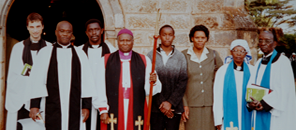The Clergy

Church Artifacts

Community Mission

All Saints’ Church Hall Building History
The plot on which the church stands was donated by Mr. Colin Campbell about 1912. The first church building was a little wood and iron structure erected on stilts which was consecrated by Bishop Heywood in 1913. By 1930s the original building was proving too small. In 1936 a fete/harambee was held in the grounds of Brackenhurst Hotel by the parishioners to build a new church. The fete/harambee raised £1200.00. Construction of the building started in 1939 and was completed a year later. The church was consecrated by Bishop of Mombasa, Reginald Perey Crabb, on 7th April 1940. A harambee on that day raised a record Kshs. 664.55 cents. The bell tower was added about 1956. The design of the building was done by Mr. A.B. McDonell, one of the earliest european settlers in Limuru, a farmer and architect. The working drawings were done by Messers Cobb and Archer, Architects in Nairobi. An Indian mason called Premji was employed for the construction. In the 1960s the parking area was moved east of the church in order to release more area for the graves on the west side. In 1957 Mr. Henry Porter donated another acre of land on which was built the present Vicar’s house and Verger’s house in 1972. The Multipurpose Church Hall and office complex have been developed on this plot. Over the years there were plans to extend the church but the extensions were considered unaffordable. Rather than extend the church, a Church Hall was considered a priority. Some seed money was made available from a trust. More money was required to build the Hall than what was in the trust. II. Multipurpose Church Hall, Class Rooms and Offices Complex: In the 1980s and 1990s the parishioners considered building a small Hall. The planned Hall was to be built in less permanent nature than the church building. One option of construction considered was in timber walling or ‘mathirebu’. The small and less permanent Hall was considered appropriate not only because of affordability but also because the congregation was small. The new small Hall would be used by the local part of the congregation. By early 2000, the local congregation had started growing. The leadership of the local congregation decided a new big and permanent hall was needed to be used for multipurpose including church service. Consultations were held between the leaders of the now large and mainly African congregation and the leaders of the declining old congregation who were mainly of European origin, led by Mr. Shaw. A committee was set up to consider appropriate design for the Hall. Several options were considered.
About 2002 under the leadership of Rev. Timothy Ranji current Bishop of the Diocese of Mt. Kenya South under whom the church falls, Waweru and Associates Architects, were appointed to design the new big and permanent Church Hall. The Hall was to have a seating capacity of 240 persons. Also in 2003, under the leadership of Vicar Professor Nguru, the Building Committee decided to increase the seating capacity of the Hall to 500 persons. The Building Committee also decided to develop offices, meeting rooms, classrooms and library together with the Hall. In 2006, under the leadership of Vicar Dr. Rev. H.M.Waweru, a decision was made to implement the project in two phases. Phase 1 was to comprise the offices, classrooms, meeting rooms and library. Phase 2 would comprise the Multipurpose Church Hall, washrooms, kitchen and external works. The foundation stone for phase 1 was laid on 18th December, 2007 by Bishop Rt. Rev. Timothy Ranji assisted by Dr. Rev. H.M.Waweru. Construction was carried out by the church through direct labour and the completed phase 1 was opened on 28th March, 2010 by Bishop Rt. Rev Timothy Ranji assisted by Rev. Samuel Ndichu. Cost of Phase 1 was Kshs. 10,000,000.00. In 2010, under the leadership of Rev. Samuel Ndichu, the Building Committee reduced the planned capacity for the Hall to 250 persons. This was because the site/location was reduced to avoid demolition of the Verger house as was intended earlier. Construction of Phase 2 was carried out under the overall supervision of the Vicars Rev. Samuel Ndichu and Rev. Lois Musyoka. The Hall was constructed under a contract by Messers MOD Builders Limited for a contract sum of Kshs. 19,500,000.00. Both phases of the development have the following facilities and capacities:
For the Dedication of Multipurpose Complex Hall on Sunday, 7th October, 2012. In the 1950’s the then Church Council decided to build a Church Hall. In response, a small wooden structure was set up to serve the Sunday School classes. This Sunday School Banda, is still standing today. It was in 1980 that the then Vicar, Rev. David Njoroge suggested that a permanent church Hall be built. It was agreed that a larger building to seat 200 with separate office, toilets and kitchen should be considered, and fund raising should start. It wasn’t until 1982 that a sketch plan was produced by Mr. George Vamos with a quote of Kshs.600,000.00. By this time, only a fraction of this had been raised. A board was placed in the church showing the progress of the fund. Mr. Joseph Koinange was in charge. They had raised about Kshs.160,000.00 which was banked through the CCK and retrieved in 2008 from Stanbic Bank amounting to Kshs.1.2 M. By 1983, for various reasons and other urgent church repairs to be catered for, fund raising was shelved, and it wasn’t until 1990 that a committee was appointed and Mr. J. G. Waweru, the architect approached. A ceiling of Kshs.500, 000.00 was set. Thereafter, between 1990 and 1997, the project was again shelved. In 1998, a committee composed of Messrs Nigel Guild, E. R. Kanjabi and Ven. J. Thuku, was formed to progress the church hall project. Once again the project stalled.
ed ut perspiciatis unde omnis iste natus error sit voluptatem accusantium doloremque laudantium, totam rem aperiam, eaque ipsa quae ab illo inventore veritatis et quasi architecto beatae vitae dicta sunt explicabo.
Read MoreHighlights
- Early 1913 The first church building was a little wood and iron structure erected on stilts which was consecrated by Bishop Heywood in 1913.
- Early 1936 In 1936 a fete/harambee was held in the grounds of Brackenhurst Hotel by the parishioners to build a new church. The fete/harambee raised £1200.00.
- 7th April 1940 The church was consecrated by Bishop of Mombasa, Reginald Perey Crabb, on 7th April 1940. A harambee on that day raised a record Kshs. 664.55 cents.
- In 1957 Mr. Henry Porter donated another acre of land on which was built the present Vicar’s house and Verger’s house.
- In 1972 The Multipurpose Church Hall and office complex have been developed on this plot.
- In 1980's - 1990's The parishioners considered building a small Hall. The planned Hall was to be built in less permanent nature than the church building. One option of construction considered was in timber walling or ‘mathirebu’. The small and less permanent Hall was considered appropriate not only because of affordability but also because the congregation was small. The new small Hall would be used by the local part of the congregation
